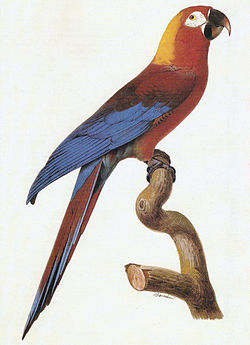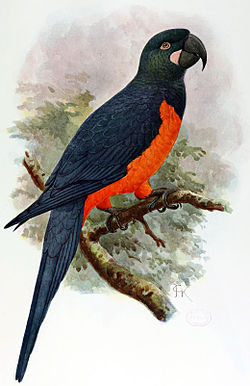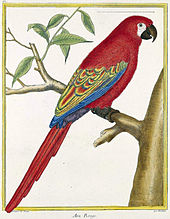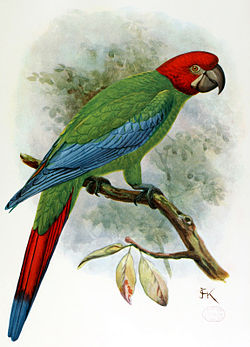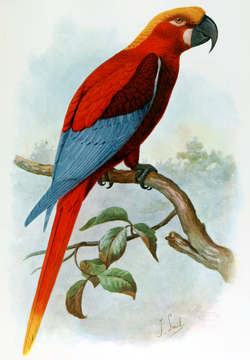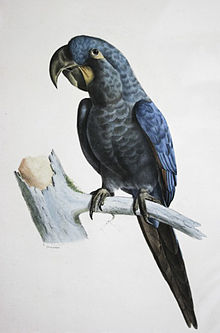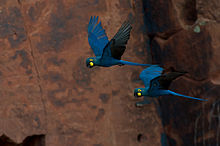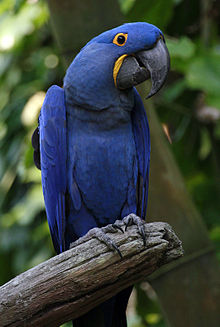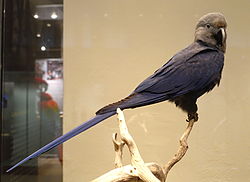The macaws are a tribe of parrots native to the New World. Many of them are larger birds, and the largest parrots are macaws. Macaws can be found in Mexico, Central America, South America, and formerly the Caribbean. Like most other parrots, they are very intelligent birds. Macaws will generally pair with other macaws for life. Even out of the mating season, they will stay together. Macaws tend to fly in a formation with one right above the other.
Macaws will eat a variety of foods including seeds, nuts, fruits, palm fruits, leaves, flowers, and stems. Wild macaws will forage very widely in search of seasonally available foods - blue and gold macaws and great green macaws have been known to travel over 60 miles in search of foods. In the western Amazon region, hundreds of macaws, joined by other species of parrots, fly down to exposed riverbanks almost daily to lick clay found here - with the exception of on rainy days, as landslides are common at this time. It has been suggested that they lick clay to neutralize toxins, however this is not verified. In Peru, macaws have been studied at clay licks. Macaws, along with other birds and bats, prefer clay that has a higher salt level, as sodium is a vital yet uncommon element when you're over 50 miles away from the ocean.
In captivity, macaws require a great deal of attention and living space. It is of the utmost importance that any macaw owner is very knowledgeable about their bird. Macaws have a relatively limited ability to mimic words - certainly not as well as the African gray parrots or some of the Amazon parrots. They will sometimes make loud noises, usually a shriek or a squawk. Breeding macaws, with the exception of the blue and gold macaw, is best left to experts with years of experience. Hand-raising the babies is the easy part - getting the babies can be difficult, and macaws tend to be aggressive during the breeding season.
Macaws have a body length of 12 to 39 inches and a body weight of 200-1,500 grams. The mini macaws are sexually mature at around 4 to 6 years of age, whereas the large macaws are sexually mature at 5 to 7 years. Macaws usually live up to 50 years, however there is a blue and gold macaw living in Reigate, Surrey (located in the UK) who was allegedly hatched in 1899 - this would make her 117 years old as of today. However, this has not been officially confirmed. The bird used to belong to Winston Churchill. In most species of macaws, it is difficult to tell the sex of a parrot based on physical characteristics. The only way to be sure is endoscopy or other laboratory methods.
Macaws are very playful birds that love to do one thing - chew. They can be very destructive birds. These birds require frequent training and structured out-of-cage play time to focus their energy. Any toys you give to your macaw must be free from toxic metals, hooks, sharp objects, and easily consumed components. You should provide your macaw with a few large diameter, fresh cut branches from non-toxic, pesticide-free trees for your bird to chew on. Here is a list of toxic and safe plants for use with your macaw.
Young, hand-raised macaws are known to readily adapt to new surroundings, people, and handling procedures. They should be exposed to "regular" situations, including car travel, hospital visits, multiple visitors in your house, and/or other pets, so that once they are older and they occur again, they are used to it. Behavior abnormalities in macaws are somewhat common. Imprinted hand-raised macaws (think of an imprinted duckling) may tend to scream for attention, and frequently pick their feathers. They may also perform an act called "social regurgitation" towards their family members. Modifying bad behaviors in a macaw requires discipline, leadership, patience, a good sense of ritual, and plenty of rewards.
In case of loss or escape, it is a good idea to have your macaw microchipped. This is a procedure where your avian veterinarian will inject a custom microchip under the skin of your bird. Individually numbered leg bands/rings are another option, but these aren't as reliable and may result in damage to the bird.
Some people decide they would like their macaw to have free roam of the house - this is a bad idea. To be kept safe, macaws need to have a confined room or cage, and they need to have their wings clipped. If left to roam around the house alone, they can encounter physical dangers, toxic items, and they can also cause a lot of destruction. Clipping the wings doesn't prevent your bird from flying - it prevents your bird from rapidly flying for long distances, which means that the bird will have a harder time escaping. This may also make the bird more dependent on you, and less aggressive.
To keep a macaw healthy, happy, and safe, you will need to:
To provide proper housing for your macaw, you should:
Macaws are very curious birds that will investigate anything in their environment. There are many common household dangers that must be avoided, including but not limited to:
To find a healthy macaw, you should look for:
The most common disorders in macaws are:
Sources
Munn C.A. 1994. Macaws: winged rainbows. National Geographic, 185, 118–140.
Brightsmith D.J. 2004. Effects of weather on parrot geophagy in Tambopata, Peru. Wilson Bulletin. 116, 134–145.
Gilardi J.D. 1996. Ecology of parrots in the Peruvian Amazon: habitat use, nutrition, and geophagy. Ph.D. dissertation. University of California at Davis, Davis, California
Powell et al. 2009. Parrots take it with a grain of salt: available sodium content may drive collpa (clay lick) selection in southeastern Peru.Biotropica 41(3):279–282.
On the biogeography of salt limitation
Macaws, your comprehensive guide
"'Hello': Having a chat with Churchill's parrot and - at 114-years-old - one of Reigate's oldest residents". Surrey Mirror.
Association of Avian Veterinarians
Macaws will eat a variety of foods including seeds, nuts, fruits, palm fruits, leaves, flowers, and stems. Wild macaws will forage very widely in search of seasonally available foods - blue and gold macaws and great green macaws have been known to travel over 60 miles in search of foods. In the western Amazon region, hundreds of macaws, joined by other species of parrots, fly down to exposed riverbanks almost daily to lick clay found here - with the exception of on rainy days, as landslides are common at this time. It has been suggested that they lick clay to neutralize toxins, however this is not verified. In Peru, macaws have been studied at clay licks. Macaws, along with other birds and bats, prefer clay that has a higher salt level, as sodium is a vital yet uncommon element when you're over 50 miles away from the ocean.
In captivity, macaws require a great deal of attention and living space. It is of the utmost importance that any macaw owner is very knowledgeable about their bird. Macaws have a relatively limited ability to mimic words - certainly not as well as the African gray parrots or some of the Amazon parrots. They will sometimes make loud noises, usually a shriek or a squawk. Breeding macaws, with the exception of the blue and gold macaw, is best left to experts with years of experience. Hand-raising the babies is the easy part - getting the babies can be difficult, and macaws tend to be aggressive during the breeding season.
Macaws have a body length of 12 to 39 inches and a body weight of 200-1,500 grams. The mini macaws are sexually mature at around 4 to 6 years of age, whereas the large macaws are sexually mature at 5 to 7 years. Macaws usually live up to 50 years, however there is a blue and gold macaw living in Reigate, Surrey (located in the UK) who was allegedly hatched in 1899 - this would make her 117 years old as of today. However, this has not been officially confirmed. The bird used to belong to Winston Churchill. In most species of macaws, it is difficult to tell the sex of a parrot based on physical characteristics. The only way to be sure is endoscopy or other laboratory methods.
Macaws are very playful birds that love to do one thing - chew. They can be very destructive birds. These birds require frequent training and structured out-of-cage play time to focus their energy. Any toys you give to your macaw must be free from toxic metals, hooks, sharp objects, and easily consumed components. You should provide your macaw with a few large diameter, fresh cut branches from non-toxic, pesticide-free trees for your bird to chew on. Here is a list of toxic and safe plants for use with your macaw.
Young, hand-raised macaws are known to readily adapt to new surroundings, people, and handling procedures. They should be exposed to "regular" situations, including car travel, hospital visits, multiple visitors in your house, and/or other pets, so that once they are older and they occur again, they are used to it. Behavior abnormalities in macaws are somewhat common. Imprinted hand-raised macaws (think of an imprinted duckling) may tend to scream for attention, and frequently pick their feathers. They may also perform an act called "social regurgitation" towards their family members. Modifying bad behaviors in a macaw requires discipline, leadership, patience, a good sense of ritual, and plenty of rewards.
In case of loss or escape, it is a good idea to have your macaw microchipped. This is a procedure where your avian veterinarian will inject a custom microchip under the skin of your bird. Individually numbered leg bands/rings are another option, but these aren't as reliable and may result in damage to the bird.
Some people decide they would like their macaw to have free roam of the house - this is a bad idea. To be kept safe, macaws need to have a confined room or cage, and they need to have their wings clipped. If left to roam around the house alone, they can encounter physical dangers, toxic items, and they can also cause a lot of destruction. Clipping the wings doesn't prevent your bird from flying - it prevents your bird from rapidly flying for long distances, which means that the bird will have a harder time escaping. This may also make the bird more dependent on you, and less aggressive.
To keep a macaw healthy, happy, and safe, you will need to:
- Give your bird lots of attention
- Feed your bird a fresh, high-quality, toxin-free, formulated diet, along with a daily supplementation of chopped fruits and vegetables
- Don't worry about providing grit for your bird - with modern-day captive bird diets, it is not necessary
- Provide fresh, clean, and uncontaminated water
- Replace food and water at least twice per day
- At least once a week, allow your bird to take a bath/shower/misting
- Avoid spraying insecticides in your house
To provide proper housing for your macaw, you should:
- Provide as large of a cage as possible for your bird
- Make sure the cage is clean, secure, safe, and easy to service
- Make sure the cage is constructed of a durable, non-toxic material (zinc is HIGHLY toxic to birds)
- Provide multiple different-sized perches made from clean, pesticide-free, nontoxic tree branches
- Keep food and water containers at opposite ends of the enclosure
- Avoid placing perches directly over top of food and/or water containers
- Provide your bird with plenty of toys that are occasionally moved around to prevent boredom and/or aggression
- Offer occasional access to the outdoors (for fresh air, sunlight (through glass does not count), and exercise)
Macaws are very curious birds that will investigate anything in their environment. There are many common household dangers that must be avoided, including but not limited to:
- Ceiling fans
- Hot cooking oil
- Overheated non-stick cookware
- Leg chains
- Sandpaper-covered perches
- Tobacco/cigarette smoke
- Chocolate
- Avocado
- Salt (don't let them get to pure salt - when they get it from clay licks, it is a lot different than straight-up table salt)
- Alcohol
- Toxic houseplants
- Pesticides
- Toxic fumes
- Easily dismantled toys
- Dogs, cats, and/or young children
- Cedar, redwood, and pressure-treated wood
- Lead and zinc
- Plug-in air fresheners
- Candles
To find a healthy macaw, you should look for:
- Dry, open nostrils
- Clear bright eyes with no discharge
- A smooth beak
- An alert and erect posture
- A body free of lumps and bumps
- Smooth, bright feathers without color breaks, transparency, and/or ragged edges
- Even, reptilian patterning on the feet
- Nails of the appropriate length
The most common disorders in macaws are:
- Aggression
- Reproductive disorders
- Feather picking and/or feather cysts
- Oral and/or cloacal papillomatosis
- Mutilation syndrome
- Chlamydiosis
- Proventricular dilatation disease
- Bacterial and/or viral infections
- Drug sensitivities
- Allergies
- Sunken eye sinusitis
- Toe deformities (more common in young macaws)
- Acne (in macaws, this is ingrown facial feathers)
- Respiratory infections
- Malcolored feathers
Sources
Munn C.A. 1994. Macaws: winged rainbows. National Geographic, 185, 118–140.
Brightsmith D.J. 2004. Effects of weather on parrot geophagy in Tambopata, Peru. Wilson Bulletin. 116, 134–145.
Gilardi J.D. 1996. Ecology of parrots in the Peruvian Amazon: habitat use, nutrition, and geophagy. Ph.D. dissertation. University of California at Davis, Davis, California
Powell et al. 2009. Parrots take it with a grain of salt: available sodium content may drive collpa (clay lick) selection in southeastern Peru.Biotropica 41(3):279–282.
On the biogeography of salt limitation
Macaws, your comprehensive guide
"'Hello': Having a chat with Churchill's parrot and - at 114-years-old - one of Reigate's oldest residents". Surrey Mirror.
Association of Avian Veterinarians


